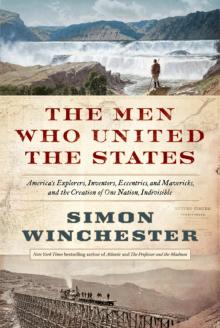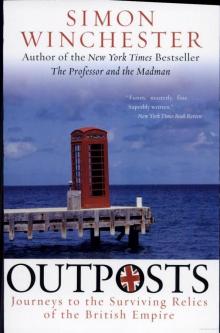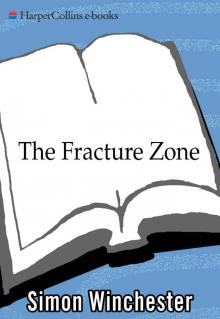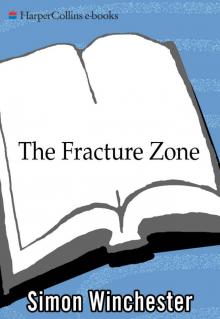- Home
- Simon Winchester
The Map That Changed the World
The Map That Changed the World Read online
Simon Winchester
The Map That Changed the World
William Smith and the Birth of Modern Geology
FOR HAROLD READING
In days of old, old William Smith,
While making a canal, Sir,
Found out how the strata dipped to the east
With a very gentle fall, Sir.
First New Red Sand and marl a-top
With Lias on its border,
Then the Oolite and the Chalk so white
All stratified in order.
Sing, cockle-shells and oyster-banks,
Sing, thunder-bolts and screw-stones,
To Father Smith we owe our thanks
For the history of a few stones.
Source: Anniversary dinner, A. C. Ramsay, 1854
Contents
Epigraph
List of Illustrations
Prologue
One Escape on the Northbound Stage
Two A Land Awakening from Sleep
Three The Mystery of the Chedworth Bun
Four The Duke and the Baronet’s Widow
Five A Light in the Underworld
Six The Slicing of Somerset
Seven The View from York Minster
Eight Notes from the Swan
Nine The Dictator in the Drawing Room
Ten The Great Map Conceived
Eleven A Jurassic Interlude
Twelve The Map That Changed the World
Thirteen An Ungentlemanly Act
Fourteen The Sale of the Century
Fifteen The Wrath of Leviathan
Sixteen The Lost and Found Man
Seventeen All Honor to the Doctor
Epilogue
Glossary of Geological and Other Unfamiliar Terms Found in This Book
Sources and Recommended Reading
Acknowledgments
Searchable Terms
About the Author
Other Books by Simon Winchester
Copyright
About the Publisher
Illustrations
CHAPTER-OPENING ILLUSTRATIONS
Incorporated in eighteen of the nineteen chapter openings (including those of the prologue and the epilogue) will be found small line drawings of Jurassic ammonites—long-extinct marine animals that were so named because their coiled and chambered shells resembled nothing so much as the horns of the ancient Egyptian ram-god, Ammon. Soun Vannithone’s drawings of these eighteen specimens are placed in the book in what I believe to be the ammonites’ exact chronological sequence. This means that the book’s first fossil, Psiloceras planorbis, which illustrates the prologue, is the oldest ammonite, and is to be found deepest down in any sequence of Jurassic sediments; by the same token the final fossil, Pavlovia pallasioides, comes from a much higher horizon, and is very much younger. Much like the epilogue it illustrates, it was fashioned last. It must be said, though, that anyone who flips rapidly from chapter to chapter in the hope of seeing a speeded-up version of the evolutionary advancement of the ammonite will be disappointed: Ammonites—floating, pulsating, slow-swimming beasts that were hugely abundant in the warm blue Jurassic seas—do not display any conveniently obvious changes in their features—they neither become progressively smaller with time, nor do they become larger; their shells do not become more complex, or less. True, some ammonites with very ridged shells do indeed evolve into smoother-shelled species over the ages, but these same creatures then become rougher and more ridged again as time wears on, managing thereby to confuse and fascinate all who study them. Only studies of ammonites from successive levels will reveal sure evidence of evolutionary change, and such study is too time consuming for the chance observer. Ammonites are, however, uniformly lovely; and they inspired William Smith: two reasons good enough, perhaps, for including them as symbols both of Smith’s remarkable prescience and geological time’s amazing bounty. However: eighteen ammonites and nineteen chapter openings? There is one additional illustration, of the microscopic cross-section of a typical oolitic limestone, which I have used to mark the heading for chapter 11. Since this chapter is very different in structure from all the others, and since much of its narrative takes place along the outcrop of those exquisitely lovely, honey-colored Jurassic rocks known in England as the Great Oolite and the Inferior Oolite, it seemed appropriate and reasonable to ask the legions of ammonites, on just this one occasion, to step—or swim very slowly—to one side.
Prologue: Psiloceras planorbis
Chapter One: Echioceras raricostatum
Chapter Two: Amaltheus margaritatus
Chapter Three: Dactylioceras tenuicostatum
Chapter Four: Harpoceras falciferum
Chapter Five: Hildoceras bifrons
Chapter Six: Sonninia sowerbyi
Chapter Seven: Stephanoceras humphriesianum
Chapter Eight: Parkinsonia parkinsoni
Chapter Nine: Zigzagiceras zigzag
Chapter Ten: Tulites subcontractus
Chapter Eleven: Oolitic Limestone
Chapter Twelve: Clydoniceras discus
Chapter Thirteen: Macrocephalites macrocephalus
Chapter Fourteen: Sigaloceras calloviense
Chapter Fifteen: Peltoceras athleta
Chapter Sixteen: Cardioceras cordatum
Chapter Seventeen: Aulacostephanoides mutabilis
Epilogue: Pavlovia pallasioides
TEXT ILLUSTRATIONS
William Smith’s 1801 Map
1. A Map Showing the Locations of the Main Prisons in London in 1819
2. Clypeus ploti (side view)
3. Clypeus ploti (top view)
4. Lobothyris
5. A Typical Coal Sequence
6. Rugborne Farm
7. The Mearns Colliery
8. The Somerset Coalfield
9. The Camerton & Limpley Stoke Railway
10. The Somerset Coal Canal
11. Tucking Mill
12. Tucking Mill House
13. An Ichthyosaur
14. A Plesiosaur
15. The Tethyan Ocean
16. Leioceras opalinum
17. The Jurassic of England (Indication of Outcrop)
18. Titanites giganteus
19. Asteroceras
20. No. 15 Buckingham Street
21. The King’s Bench Prison
22. Ammonites sublaevis
23. Scarborough City Museum
24. Hackness Hall
25. The Sheldonian Theatre
26. Detail of ornate stonework at the House of Commons
27. Geological Time Scale
A NOTE ON THE MAP INSERT
The brilliance of William Smith’s achievement can be amply demonstrated by comparing his great map of 1815 with the one produced today by the British Geological Survey. The similarity of so much of the detail—visible even at a scale where much cannot be seen—is proof absolute of the accuracy and prescience of Smith’s work, yet does not admit of the one signal difference between the two productions: that while the survey map is the fruit of the labors of thousands, William Smith’s map, drawn a century and a half before, is the result of the dedication and determination of one man who worked for almost twenty years, always entirely alone.
Prologue
Psiloceras planorbis
Above one of the many grand marble staircases within the east wing of Burlington House, the great Palladian mansion on the north side of London’s Piccadilly, hangs a pair of huge sky blue velvet curtains, twisted and tasseled silk ropes beside them. Although many may wonder in passing, rarely does any one of the scores of people who climb and descend the stairs inquire as to what lies behind the drapes. A blocked-off window, perhaps? A painting too grote
sque to show? A rare Continental tapestry, faded by the sunlight?
Once in a while someone curious and bold will demand a look, whereupon a functionary will emerge from behind a door marked Private, and with practiced hand will tug gently on the silk ropes. The curtains will slowly part, revealing an enormous and magnificent map of England and Wales, engraved and colored—in sea blue, green, bright yellow, orange, umber—in a beguiling and unfamiliar mixture of lines, patches, and stippled shapes.
“The German Ocean,” it says to the east of the English coast, instead of today’s “North Sea.” There is, in an inset, a small cross-section of what is said to be the underside of the country from Wales to the river Thames. Otherwise all is readily familiar, comfortingly recognizable. The document is exquisitely beautiful—a beauty set off by its great size, more than eight feet by six—and by the fact that it towers—looms, indeed—above those who stand on the staircase to see it. The care and attention to its detail is clear: This is the work of a craftsman, lovingly done, the culmination of years of study, months of careful labor.
At the top right is its description, engraved in copperplate flourishes: “A Delineation of The Strata of England and Wales with part of Scotland; exhibiting the Collieries and Mines; the Marshes and Fen Lands originally Overflowed by the Sea; and the Varieties of Soil according to the Variations in the Sub Strata; illustrated by the Most Descriptive Names.” There is a signature: “By W. Smith.” There is a date: “Augst 1, 1815.”
This, the official will explain, is the first true geological map of anywhere in the world. It is a map that heralded the beginnings of a whole new science. It is a document that laid the groundwork for the making of great fortunes—in oil, in iron, in coal, and in other countries in diamonds, tin, platinum, and silver—that were won by explorers who used such maps. It is a map that laid the foundations of a field of study that culminated in the work of Charles Darwin. It is a map whose making signified the beginnings of an era not yet over, that has been marked ever since by the excitement and astonishment of scientific discoveries that allowed human beings to start at last to stagger out from the fogs of religious dogma, and to come to understand something certain about their own origins—and those of the planet they inhabit. It is a map that had an importance, symbolic and real, for the development of one of the great fundamental fields of study—geology—which, arguably like physics and mathematics, is a field of learning and endeavor that underpins all knowledge, all understanding.
The map is in many ways a classic representation of the ambitions of its day. It was, like so many other grand projects that survive as testament to their times—the Oxford English Dictionary, the Grand Triangulation of India, the Manhattan Project, the Concorde, the Human Genome—a project of almost unimaginably vast scope that required great vision, energy, patience, and commitment to complete.
But a signal difference sets the map apart. Each of the other projects, grand in scale, formidable in execution, and unassailable in historical importance, required the labor of thousands. The OED needed entire armies of volunteers. To build the Concorde demanded the participation of two entire governments. More men died during the Indian triangulation than in scores of modest wars. The offices at Los Alamos may have housed behind their chain-link fences shadowy figures who would turn out to be Nobel laureates or spies, but they were all hemmed in by immense battalions of physicists. And to attend to all their various needs—be they bomb makers, plane builders, lexicographers, codifiers of chemistry, or measurers of the land—were legions upon legions of minions, runners, amanuenses, and drones.
The incomparably beautiful geological map of 1815, however, required none of these. As vital as it turned out to be for the future of humankind, it stands apart—because it was conceived, imagined, begun, undertaken, and continued and completed against all odds by just one man. All the Herculean labors involved in the mapping of the imagined underside of an entire country were accomplished not by an army or a legion or a committee or a team, but by the single individual who finally put his signature to the completed document—William Smith, then forty-six years old, the orphaned son of the village blacksmith from the unsung hamlet of Churchill, in Oxfordshire.
And yet William Smith, who created this great map in solitary endeavor, and from whose work all manner of benefits—commercial, intellectual, and nationalistic—then flowed, was truly at first a prophet without honor. Smith had little enough going for him: He was of simple yeoman stock, more or less self-taught, stubborn and visionary, highly motivated, and single-minded. Although he had to suffer the most horrendous frustrations during the long making of the map, he never once gave up or even thought of doing so. And yet very soon after the map was made, he became ruined, completely.
He was forced to leave London, where he had drawn and finished the map and which he considered home. All that he owned was confiscated. He was compelled to live as a homeless man for years, utterly without recognition. His life was wretched: His wife went mad—nymphomania being but one of her recorded symptoms—he fell ill, he had few friends, and his work seemed to him to have been without point, without merit.
Ironically and cruelly, part of the reason for his humiliation lies behind another set of faded velvet curtains that hang nearby, on another of Burlington House’s many elaborate staircases. There, it turns out, is quite another map, made and published shortly after William Smith’s. It was in all essentials a copy, made by rivals, and it was made—if not expressly then at least in part—with the intention of ruining the reputation of this great and unsung pioneer from Oxfordshire: a man who was not gently born, and who was therefore compelled, like so many others in those times, to bear the ungenerous consequences of his class.
But in the very long run William Smith was fortunate. A long while after the map had been published, a kindly and liberal-minded nobleman for whom Smith had been performing tasks on his estate in a small village in Yorkshire, recognized him—knew, somehow, that this was the man who had created the extraordinary and beautiful map about which, it was said, all learned England and all the world of science outside was talking.
This aristocratic figure let people—influential and connected people—know about the man he had discovered. He reported that he was hidden, incognito, in the depths of the English countryside. He supposedly had no expectation that anyone would now ever remember, or would ever recognize, the solitary masterpiece that he once had made. He imagined he was doomed to suffer an undeserved oblivion.
But on this occasion his pessimism was misplaced: The messages that had been sent did get through—with the consequence that, eventually, William Smith was persuaded to return to London, to receive at last the honors and rewards that were due him, and to be acknowledged as the founding father of the whole new science of English geology, a science that remains at the core of intellectual endeavor to this day.
It is now exactly two hundred years since William Smith began work on the map that changed the world. What follows, drawn from his diaries and letters, is a portrait of both a long-forgotten man and the world in which he lived and worked, as well as the story of his great map, which has remained hidden behind the blue velvet curtains of a great house in London far too long.
The map that was to become “the map that changed the world.” Completed in 1801, this very basic sketch still has an uncanny accuracy.
1
Escape on the Northbound Stage
Echioceras raricostatum
The last day of August 1819, a Tuesday, dawned gray, showery, and refreshingly cool in London, promising a welcome end to a weeklong spell of close and muggy weather that seemed to have put all the capital’s citizens in a nettlesome, liverish mood.
Anyone trying to hurry along the cobbled and granite-paved streets that day was still certain to be frustrated, despite the improvement in the weather: The crowds! The crush! The dirt! The smell! More than a million people had lately been counted as living within and beyond London’s city walls, and each day h
undreds more, the morning papers reported, were to be found streaming in from the countryside, bent on joining the new prosperity that all hoped might soon be flowering now that the European wars were over. The city’s population was well on the way to doubling itself in less than twenty years. The streets were in consequence filled with a jostling, pullulating, dawdling mass of people. And animals, too: It seemed of little matter to some farmers that there had long been laws to keep them from driving cattle through the center of town—so among the throngs one could spot mangy-looking sheep, more than a few head of cattle, the odd black pig, and of course horses, countless horses, pulling carriages and goods vehicles alike. The stench of their leavings, on a hot week such as this had been, was barely tolerable.
Since it was very early in the morning, there were, of course, fewer crowds than usual. Fewer, that is, except in one or two more notorious spots, where a sad and shabby ritual of the dawn tended to bring out the throngs—and where this story is most appropriately introduced.
The better known of the London sites where the morning masses gathered was in the rabbit warren of lanes that lay near Saint Paul’s Cathedral, to the east of where the river Fleet had once run. Halfway along the Fleet Market a passerby would have noted, perhaps with the wry amusement of the metropolitan sophisticate, that crowds had gathered outside a rather noble, high-walled building whose address, according to a written inscription above the tall gateway, was simple: Number Nine.
An onlooker would have been amused because the address was a mere euphemism, the building’s real purpose only too well known. The streets to the west of Saint Paul’s were one of the two districts of nineteenth-century London where a clutch of the capital’s many prisons were concentrated: the Newgate, the Bridewell, the Cold Bath Fields, and the Ludgate jails had all been built nearby, in what in winter were the chill gloom and coal-smoke fogs of the river valley. And Number Nine was the site of the best known of them all, the prince of prisons, the Fleet.

 The Surgeon of Crowthorne
The Surgeon of Crowthorne Korea: A Walk Through the Land of Miracles
Korea: A Walk Through the Land of Miracles The Men Who United the States: America's Explorers
The Men Who United the States: America's Explorers Outposts: Journeys to the Surviving Relics of the British Empire
Outposts: Journeys to the Surviving Relics of the British Empire Atlantic: Great Sea Battles, Heroic Discoveries, Titanic Storms
Atlantic: Great Sea Battles, Heroic Discoveries, Titanic Storms The Professor and the Madman: A Tale of Murder, Insanity
The Professor and the Madman: A Tale of Murder, Insanity A Crack in the Edge of the World
A Crack in the Edge of the World The Perfectionists: How Precision Engineers Created the Modern World
The Perfectionists: How Precision Engineers Created the Modern World The Man Who Loved China: The Fantastic Story of the Eccentric Scientist
The Man Who Loved China: The Fantastic Story of the Eccentric Scientist The River at the Center of the World: A Journey Up the Yangtze
The River at the Center of the World: A Journey Up the Yangtze The Fracture Zone: My Return to the Balkans
The Fracture Zone: My Return to the Balkans The Map That Changed the World
The Map That Changed the World Krakatoa: The Day the World Exploded
Krakatoa: The Day the World Exploded The Man Who Loved China
The Man Who Loved China The River at the Centre of the World
The River at the Centre of the World Bomb, Book and Compass
Bomb, Book and Compass The Perfectionists
The Perfectionists The Meaning of Everything
The Meaning of Everything Exactly
Exactly Atlantic
Atlantic Korea
Korea The Fracture Zone
The Fracture Zone Pacific
Pacific Krakatoa
Krakatoa The Professor and the Madman
The Professor and the Madman Outposts
Outposts